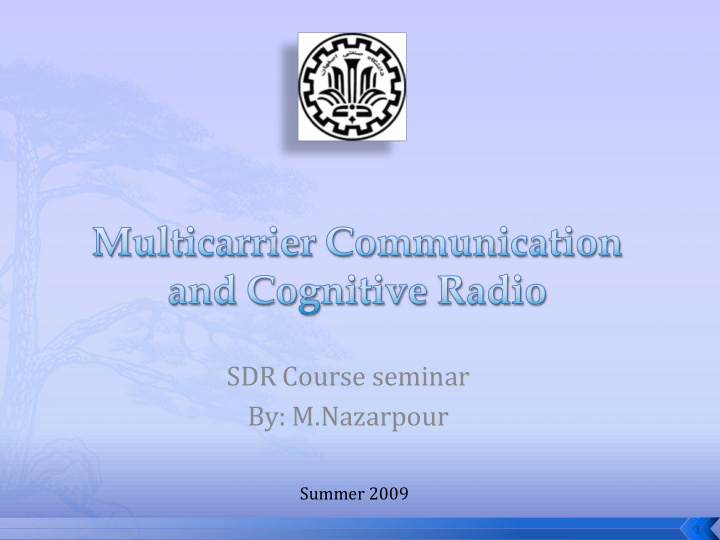



SDR Course seminar By: M.Nazarpour Summer 2009 1
Introduction about mc and OFDM A Basic OFDM System Model OFDM-Based Cognitive Radio Merits Challenges Multi-band OFDM 2
Single carrier system signal representing each bit uses all of the available spectrum Multicarrier system available spectrum divided into many narrow bands data is divided into parallel data streams each transmitted on a separate band 3
OFDM is a multicarrier system uses discrete Fourier Transform/Fast Fourier Transform (DFT/FFT) sin(x)/x spectra for subcarriers Available bandwidth is divided into very many narrow bands Data is transmitted in parallel on these bands 4
Multi-path fading Doppler shift 5
Shorter than subcarrier bandwith from bandwith coherence (solving frequency selective fading) Longer than symbol period from time coherence (deal with fast fading) There exists an optimum value of these parameters that should be used to improve the system performance Interleaving (for burst error) Cyclic prefix Trick to avoid residual ISI 6
7
8
The underlying sensing and spectrum shaping capabilities together with flexibility and adaptiveness make OFDM probably the best candidate for cognitive radio systems. we present some of the requirements. 9
Spectrum Sensing and Awareness Cognitive radio should be able: Scan the spectrum measure power availability, interference, and noise System should be able to identify different users, licensed or rental users The processing time is very important Inherent FFT operation of OFDM eases spectrum sensing in frequency domain conversion from time domain to frequency domain is achieved inherently by using DFT 10
Spectrum Shaping By disabling a set of subcarriers, the spectrum of OFDM signals can be adaptively shaped to fit into the required spectrum mask. 11
Advanced Antenna Techniques Diversity combining, and space-time equalization is easy in smart antenna Increases the capacity of MIMO – OFDM 12
Multiple Accessing and Spectra Allocation OFDM supports the well-known multiple accessing techniques (TDMA, FDMA, CSMA, MC – CDMA) In OFDMA, subcarriers are grouped into sets each of which is assigned to a different user assignment schemes: randomized, or clustered 13
Interoperability ability of two or more systems or components to exchange information and to use the information that has been exchanged 802.15.1 & 802.11.b FHSS 2.4 GHz 80.2.15.2 coexistence 14
15
Spectrum Shaping determining the subcarriers to be used by the OFDM system while keeping the interference to and from primary users at a negligible level Effective Pruning Algorithm Design Pruning means that eliminate the subcarriers is deactivated efficiency of FFT algorithms can be increased and / or execution time can be decreased Designing effective pruning algorithms is important for cognitive OFDM systems for achieving higher performance. 16
Signaling the Transmission Parameters The receiver, should be informed about subcarriers that are deactivated and that are to be used. Signaling of this information should be performed carefully. A. M. Wyglinski (2006). The activation/deactivation of subcarriers is performed over a block of subcarriers instead of each individual subcarrier. Hence, the signaling overhead can be reduced by a factor of each block’s size. FFT size, CP size, etc. can be changed and this information should also be conveyed to the receiver. 17
Synchronization To keep the orthogonality between subcarriers and avoid interference, all users should be synchronized to the receiver. The NBI, which can interfere with the preamble. Pilots might fall into unused subcarriers if used Longer preambles are needed in CR-OFDM systems as compared to conventional systems. 18
Mutual Interference 1- Raised cosine windowing in transmitter 2- windowing in receiver (1+ α )N sample are chosen 3- Subcarrier weighting 19
While using a single band simplifies the system design Processing a wide band signal requires building highly complex RF circuitry for signal transmission/reception High speed ADCs are required Higher complexity channel equalizers] System hardware as smaller portions of the spectrum are processed at a time Dividing the spectrum into smaller bands allows for better spectrum allocation The system can drop some of the available bands to achieve other goals 20
21
WiMAX – IEEE 802.16d IEEE 802.22 IEEE 802.11k 22
Conclusion OFDM technique is used in many wireless systems and proven as a reliable and effective transmission method. By employing OFDM transmission in cognitive radio systems; adaptive, aware and flexible systems that can interoperate with current technologies can be realized. 23
Thanks 24
More recommend